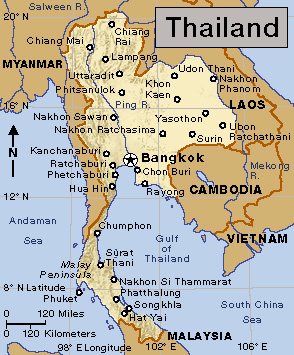Chiang Mai, << chee AHNG my or jee AHNG my >> (pop. 134,000), is a cultural, educational, and tourist center in northern Thailand. The city’s name is also spelled Chiengmai. Chiang Mai lies in a broad, fertile valley about 465 miles (750 kilometers) north of Bangkok. The city is linked to the south by road, rail, and air.

The older part of Chiang Mai, on the western bank of the Ping River, includes a walled city area that dates from the 1700’s. The eastern side of the city has modern hotels clustered around a railway station. Chiang Mai has many skilled craftworkers. Local specialties include lacquerware, pottery, silk, and umbrellas.
The region around Chiang Mai was once the heart of an independent Lao state, and much of the local population is of Lao ancestry. The city was founded in 1296 by Mangrai, a Thai king. He made it the capital of the Lan Na kingdom. Chiang Mai soon became a major religious, cultural, political, and commercial center. Many temples built during the 1300’s and 1400’s are popular tourist attractions.
From 1558 to 1774, the city was occupied by the Burmese. Local culture shows a Burmese influence, making the city different from cities in southern Thailand. Phraya Taksin, a Thai general who later became king, drove out the Burmese in the late 1700’s. The region later became a province of Siam, as Thailand was known until 1939.
